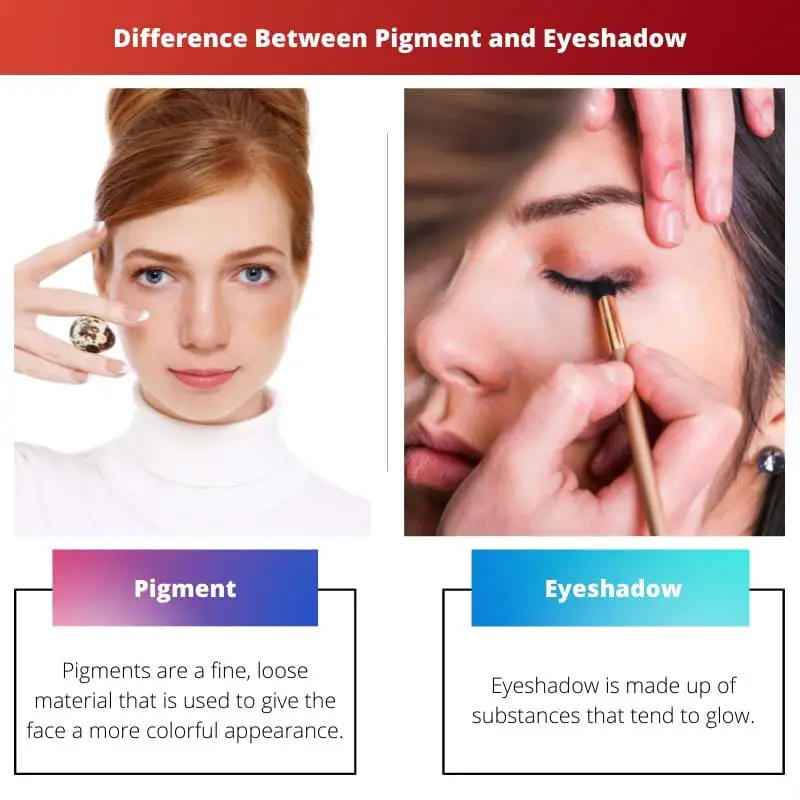Women’s makeup is just as crucial as their regular attire. And, because both pigment and eyeshadow are useful, they are both a must-have for women.
They’re both loving parts of the makeup boxes till they bring many colors to the face of women, and blush appears to give grace to a woman’s face.
Conversely, women have been more interested in makeup and influencing others for fashion in recent years. As a result, they’ve become more aware of the distinctions between color and eyeshadow.
Key Takeaways
- Pigments are pure, powdered colorants used in various industries, while eyeshadow is a cosmetic product designed specifically for eyelids.
- Eyeshadow contains pigments as colorants and binders, fillers, and other ingredients for easy application and adherence.
- Pigments offer more versatility and can create custom makeup colors, whereas eyeshadow comes in pre-formulated shades.
Pigment vs Eyeshadow
Pigment and eyeshadow are both used as makeup. Pigment is a highly concentrated loose powder made of pure color pigments, and pigment is versatile in application. Eyeshadow is a pressed powder that may contain additional ingredients like binders, preservatives, and shimmer, and it offers easier application.

A pigment is a component that helps in changing the color when visible light, or wavelength, is bounced on it. A pigment is a solid substance with high colors that are obtained by exposing it to constant, moderate, to high temperatures.
Pigments are offered in solid form and pulverized for application, mostly on the face’s eyes, cheeks, lips, and other parts.
Powder and mica are used to make eyeshadow. The latter is a silicate element with a glistening crystal-like appearance. Eyeshadows are commonly used by adding binders & fillers, making the impression more colorful.
It can only be used on the eyes, and it can’t be used on any other parts of the face. It also only lasts a short time because of its synthetic nature, necessitating constant retouching.
Comparison Table
What is Pigmeant?
Pigments are a fine, loose material that is used to give the face a more colorful appearance. When a binder is used, the pigment’s color is dulled.
The heavily colored loose powder is known as a pigment when there is no binder present. Pigments are sparkly, although they can also be matte.
One of the most important things about pigments is that they are made out of natural minerals, and they use natural light to give a desirable colorful effect.
You can use pigments in a variety of ways, such as applying them to your eyes. “Adding pigment to a lower eyelid is quick and easy, yet it still looks gorgeous! Use a firm, flat brush to pick up a light shade from your pigment lid or a level surface and gently pat on the lid.
You can either maintain the color below the crease or raise it just past it “.
Pigment arrives in dry powder, making it much easier to apply, but even with a small amount, the color appears richer. The tough aspect is that you’ll need to have a primer to keep the colors from fading.
If someone has to give an opinion on of based on the overall effect provided by pigment makeup, there is a great probability that one would say that pigment makeup is more vibrant and has given a realistic degree of sheen.
What is Eyeshadow?
Eyeshadow is made up of substances that tend to glow. Several popular eyeshadows are powdered and contain talc, however, crème and liquid shadows are also available.
Creamy shadows are used above the crease of the eye and not below since they can create a crepe-like texture, making the eyes appear older.
Both cream and liquid eyeshadows work well as a basis for powdered eyeshadow, giving them a “wet” or sparkling appearance.
Applying different shades of eyeshadow from one inner corner to another, mixing from light to dark, is the conventional way to utilize eyeshadow.
Beginning with light colors from the inside border and working your way to the dark would make your eyes appear bigger and further and further apart.
Light colors are utilized to emphasize and accent the shape of the eye, whereas dark hues are used to shade and softly shift the contour.
You may use eyeshadow as an eyeliner as well. Gently sweep eyeshadow underneath the lower lash line and above the top lashes with an angled brush, tracing the lash line closely.
Many shadows are used wet or dry, however, when soaking eyeshadow, make sure you only wet one area at a time and leave the rest dry. If you wet your eyeshadow again after it’s been already wet, it won’t apply as smoothly as it should be.

Main Differences Between Pigment and Eyeshadow
- Pigment and eyeshadow are differentiated by the point that pigments are created with natural minerals, whereas most of the eyeshadows are created using artificial materials.
- Pigment needs visible light, which is known as wavelength, which changes color, whereas eyeshadow doesn’t really.
- Pigments are offered in crushed form as basic chemicals that require primers to apply, but eyeshadow is made up of binders and fillers that give it its shape and color; eyeshadow does not require a primer to apply.
- Eyeshadow is just for the eyes, while pigments can be used on the eyes, cheeks, and lips.
- The pigment is comfortable to apply, it feels light and comfortable on the skin and gives a natural appearance to the consumer. Eyeshadow gives the eyes individuality and requires 2 to 3 layers of makeup.




